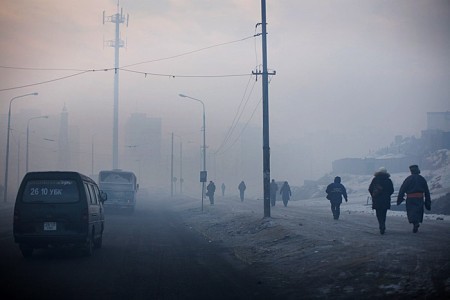The Times Are They A-Changin' in Mongolia? Green Development as an Opportunity in Times of Economic Downturn

28 November 2016, Ulaanbaatar, Mongolia - Mongolia is known for its pristine nature, clear lakes and rolling hills. On a Thursday morning in November this beauty seems far away. Ulaanbaatar city is covered in smog; people crossing the street wear masks. Concentrations of fine particulate matter reach 645 μg/m3 – 25 times higher than what the World Health Organization qualifies as acceptable. 80% of the winter air pollution is attributed to the burning of coal.

“We need to move our economy from brown to green!” exclaims Ms. D. Oyunkhorol, Minister of Environment and Tourism at a high-level event at the Government House. “Air pollution is causing lung cancer and respiratory diseases with significant costs for our public health system”, she adds. It’s not just the environment community that is calling for action to address pressing challenges such as rapidly increasing carbon emissions, declining water resources and uncontrolled use of chemicals. The event under the theme ‘Mongolia’s Pathway to Sustainable Development’ is jointly hosted by the Ministry of Finance (MOF), the Ministry of Environment and Tourism (MET), the Prime Minister’s Office, and the Economic Standing Committee of the Mongolian Parliament.

Ms. B. Lakshmi, Director of the Economic Policy and Competitiveness Research Center (EPRCR), a local think tank, highlights that green investments make sense from an economic perspective. “We have evidence that by investing only 2% of GDP in green development, growth levels could be sustained at 4.2% compared to 2.4% under a business-as-usual scenario”, she emphasizes. The numbers are based on a study supported by the Partnership for Action on Green Economy (PAGE) in collaboration with MOF and MET. “The job potential of a green economy in Mongolia is also significant”, Ms. E. Erdenesan, Director of the Economic Statistics Department of the National Statistics Office (NSO) stresses. Since 2014, NSO with support of PAGE has started to collect information on green jobs as part of the National Labour Force Survey. The data shows that 33.1% of jobs in Mongolia are in environmental sectors, but only 10% are green jobs, i.e. environmentally-sustainable and decent.
The banking sector in Mongolia is already actively supporting green investments. Mr. Orkhon Onon, President of the Mongolian Bankers Association (MBA) explains: “All our members have introduced a set of sustainable finance principles, integrating environmental and social risk assessments in their lending and investment operations. We are now working on the establishment of a green credit fund.” A new initiative – the UN Environment Inquiry – is going even a step further. “Dedicated finance for green projects is important, but to really bring about the change we need, we have to look at the rules that govern the financial sector”, claims Mr. Mark Halle, Senior Advisor to the Inquiry, speaking in front of 300 people at the Fourth Mongolian Sustainable Finance Forum on Friday.
While ‘green’ and ‘sustainable’ is in everybody’s mouth, the new Government, which took office in mid-2016, is in a difficult situation. Public debt levels are reaching 90% of GDP and economic growth is down to 0.7% from 17% in 2011. The priority is to attract foreign investment and stabilize the economy. At the same time there is a realization that Mongolia needs to diversify its extractive-based economy to reduce vulnerability to fluctuations in global commodity markets and to ensure that growth is both inclusive and sustainable.

“Our message is: green investments can push economic growth, and social expenditures are needed to protect the 20% of the population that is still living under the poverty line”, states Ms. Beate Trankmann, UN Resident Coordinator in Mongolia. “With the Sustainable Development Vision 2030 and the National Green Development Policy, Mongolia has an ambitious framework and is one of the early movers on the new 2030 Development Agenda. As the UN system we stand behind the Government to turn this ambitious vision into action.”
By 2030 Mongolia “aspires to be amongst leading middle-income countries with stable and democratic governance and a multi-sector economy, which preserves ecological balance”. Some of those that might be in charge by then are currently studying at Mongolian universities. Prof. Bat Buyantsogt from the National University of Mongolia highlights: “We need to build the capacity of those that will be the future decision-makers in government, businesses and civil society”. 90,000 students are currently enrolled in national universities. PAGE is supporting the integration of green economy approaches into the curricula of tertiary institutions. A young professor of economics is volunteering to lead the work among departments of business administration. Are the times going to change in Mongolia? “I want my children to live in a healthy environment; I believe we can make a difference”, she says, putting on her mask to walk out into the grey cold.

About PAGE
The Partnership for Action on Green Economy (PAGE) has been working with the Government and a range of national stakeholders since 2013 to advance green development in Mongolia. The partnership brings together the expertise of five UN agencies - UNEP, ILO, UNDP, UNIDO and UNITAR, offering a comprehensive package of technical assistance and capacity building services.
Photo 1: Ulaanbaatar in winter time. Source: https://mininmongolia.wordpress.com/tag/smog/
Photo 2: Ms. D. Oyunkhorol, Minister of Environment and Tourism speaking at the Government House. Source: PAGE/ Horstbrink
Photo 3: Ms. Beate Trankmann, UN Resident Coordinator in Mongolia reflecting on SDG implementation in Mongolia. Source: PAGE/ Naqvi
Photo 4: Mongolian countryside. Source: Mazzali/flickr

